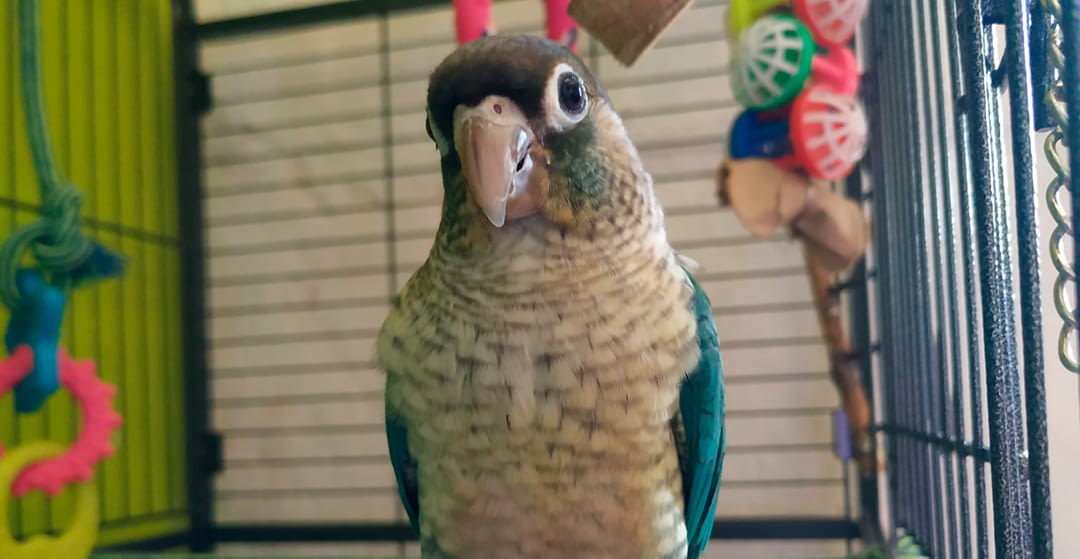
The responsible maintenance of exotic animals is a task that requires a deep understanding of the specific needs and behaviors. Parrots of the genus pyrrhura, known for their beauty and charm, are no exception to this rule.
Keeping these birds in the home requires careful attention to their environment, diet, enrichment, and health.
CHARACTERISTICS
Species diversity: The genus Pyrrhura includes more than 30 different species of parrots, all native to Central and South America. Some of the best known species include the red-headed parrot (Pyrrhura rhodocephala) and the green-cheeked parrot (Pyrrhura molinae) because of what they look like in their ancestral coloration, which we focus on in this article.
Appearance: The most distinctive feature of these small feathered birds is that they have a kind of collar of green and white (or grayish) feathers, the structure of the body and back feathers are green, and their long tail is red. The longest feathers on the wings are blue and on the chest they have a red part. The head is usually a little darker and the cheeks are colored green.
They are small in size, they can measure 25 centimeters from the head to the tip of the tail. However, its weight does not exceed 70 grams.
Longevity: Because they have been kept in captivity for a relatively short time, there is no exact data yet, but it is believed that, with adequate care, these parrots can live between 20 and 25 years.
Behavior: They are active, playful, curious and social birds that enjoy the company of other parrots and their human caregivers, highlighting that they can become super affectionate, which, a priori, should not be a bad thing, however, it can lead to to problems in coexistence since when seeking affection and affection once the bond with some has been created, there may be conflicts with others.
According to experts, it often happens that they have people with whom they get along very well and others with whom they get along very badly and, especially in hormonal times, such as adolescence, coexistence can be very complicated at home, since they can adopt behaviors aggressive, although after this period they can return to normal.
It may also be the case that this does not happen, depending on how coexistence has been managed during the hormonal period.

THE ENRICHMENT OF THE HABITAT, KEY TO YOUR HAPPINESS
Like the vast majority of parrots, these parrots are social, so, since in nature they live in groups, in captivity we must, at least, have two or a small group. However, to keep more than one Pyrrhura you need a space similar to that of nymphs, since they are very active animals and they really like to play (hang, move, climb...).
Therefore, it is essential to provide them with branches or perches so they can climb and explore, as well as safe toys to keep them entertained and mentally stimulated. They like toys that they can chew and explore.
They must have different opportunities to move around and enjoy a changing environment. Experts advise changing the structure of the cage once a week, varying elements and introducing new ones, spending time playing with them and talking to them.
Additionally, they can be taught basic tricks and commands during their training time. Using positive reinforcements like rewards can be effective.
FEEDING
Another important aspect that we must take into account when keeping these birds in captivity is their diet. They are generalist animals, so the usual rule is followed: feed base, a part of fruits and vegetables and another smaller block of extra food (pasta, legumes, seed mix). They also tend to like various shoots and flowers, and they can even be given insects sporadically.
Regarding the warnings regarding their diet and as with other species, Pyrrhuras are animals that tend to overfeed, therefore this must be taken into account to control the quantities and weight of the animal. Above all, do not give them foods that are toxic to birds, such as avocado and chocolate.
Logically, they must always have access to fresh, clean water.
BUY THEM IN SPAIN
Regarding its acquisition and given the imminent entry into force of the new Animal Protection and Welfare Law in Spain, mention that the law prohibits the direct sale of any type of pet through the Internet or any telematic means or application. Also in pet stores or by individuals. They can only be purchased from registered breeders and without the intervention of intermediaries.
Even so, and with uncertainty in the sector, a definitive list of what these companion animals are is still pending, as established therein. Only dogs, cats and ferrets are mentioned, waiting for the Scientific and Technical Committee for the Protection and Rights of Animals to prepare the final list.
This list would be developed within a maximum period of between three and four years, and will be organized into lists of mammals, reptiles, birds, amphibians, fish and invertebrates.
Therefore, to acquire a Pyrrhura parrot you can still go to a specialized store or a registered breeder, always requiring the necessary associated documentation since they are part of the CITES appendices.



